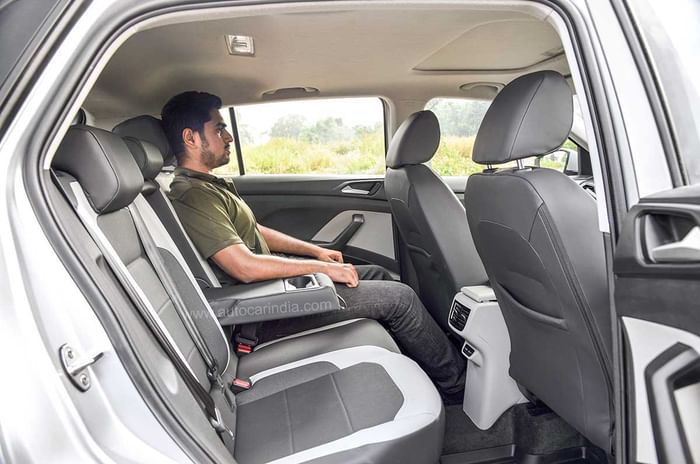After driving the all-new Volkswagen Taigun GT with the 1.5-litre TSI turbo-petrol engine, we’ve established that it is a solid, sophisticated and sporty midsize SUV. We now turn the spotlight on the variant that’s likely to comprise a lion’s share of the Taigun’s sales – 1.0-litre TSI manual version – owing to its more affordable pricing that ranges from Rs 10.50 lakh-14.57 lakh (ex-showroom, India).

Volkswagen’s 1.0-litre TSI engine made a stonking debut in the Polo in 2020, punching well above its weight in terms of performance and smoothness. Can this smaller capacity TSI engine hold its ground in this midsize SUV that weighs 203kg more than the Polo?
Volkswagen Taigun 1.0 TSI: what is it like to drive?
Before getting to the drive experience, we must commend the TSI’s refinement, which is so good that the typical three-cylinder engine thrum is barely audible unless revved hard. That said, this motor isn’t as vibe-free as a four-cylinder, and you can feel vibrations on the seats as the engine flutters on its mounts.
In the Taigun, the 999cc turbo-petrol engine gets a minor bump of 5hp and 3Nm of torque over the Polo, taking the figures to 115hp and 178Nm. Within metres of driving the Taigun, its engine character feels identical to that of the Polo TSI’s. The unit needs to be kept on the boil and spun beyond 1,800rpm to extract the best out of it, and in that respect, it isn’t as responsive or lag-free as the 1.5 TSI that does duty in the Taigun GT variant. Once on boost, however, power flows in a smooth, uninterrupted manner and this tiny motor continues to pull all the way till the red line.

It’s interesting to know that despite sharing its components, ancillaries, as well as gear ratios with the Kushaq, in a drag race, the Taigun 1.0 TSI is half-a-second quicker than the Skoda to 100kph, further widening the gap to 2.7sec by the time the cars hit 160kph. What’s surprising is that the Taigun’s 0-160kph time of 30.42sec is at par with the lighter Polo’s 30.36sec. In a rolling race from 20-80kph in third gear, the Taigun is a second quicker, and from 40-100kph in fourth gear, it is 1.5sec quicker than both Kushaq and Polo, both of which have similar in-gear acceleration times. We’ve learnt that the final software map is unique for Volkswagen and Skoda, which could be the reason behind the Taigun’s and Kushaq’s performance variance.

Volkswagen’s 6-speed manual gearbox isn’t butter-smooth and its clutch is springy, so these don’t make the drive experience as effortless as the naturally aspirated rivals the Taigun competes with.

What impressed us during the first drive was the Taigun’s highway stability, and it continues to do so in this 1.0 TSI iteration. It drives with a sense of maturity and confidence that we’ve come to expect from European cars, but at the same time, it feels a bit stiff-kneed at lower speeds and tends to toss you around a bit while dealing with some sharper potholes. Having a platform (MQB A0 IN) that’s 30 percent stiffer than that of the outgoing Polo’s makes hustling this midsize SUV around corners quite rewarding, and what’s nice is that its steering feels adequately weighted the faster you go.
Volkswagen Taigun 1.0 TSI: what is different compared to the 1.5 GT?
The silver body paint on our test car helped mellow down the India-specific chrome treatment on the bumpers, making it appear a lot more palatable. The fully loaded Topline variant gets silver 17-inch alloys that sport a design similar to the ones on the 1.5 GT Plus variant; the diamond-cut treatment is reserved for the GT variant. Even fender embellishments like the ones on the GT variants are missing here, but these aside, the 1.0 TSI looks identical to the GT Plus variant that we reviewed earlier.

The most prominent change inside is its digital instrument cluster, which now wears a blue theme and looks even more pleasing than the GT version’s red theme. Other nuances include white ambient lights that replace the red ones in the GT, different seat upholstery, and the only feature addition over the GT Plus variant are its ventilated front seats. Space, seat comfort, practicality, and even build remain identical to the GT variants we reviewed earlier.

Volkswagen Taigun 1.0 TSI: should I buy one?
The Taigun’s appeal lies in its solid build and its fun-to-drive nature. The variant in question – 1.0 TSI Topline, priced at Rs 14.57 lakh – gets you premium kit like auto LED headlamps, auto wipers, ventilated front seats, sunroof, digital instrument cluster and six airbags, among other things. All of these are missing in the 1.5 TSI GT manual, and is priced at a premium of Rs 43,000. In fact, the 1.0-litre is so good, it is smooth and quick, and is hence likely to satiate the performance needs of most buyers. As a result, a majority of buyers, with the exception of a few ardent driving enthusiasts, are likely to question the need to spend more for the 1.5 TSI. Because of its strengths, the Taigun 1.0 TSI manual comes across as the more sensible pick from the range.































